LEXUS RX350 2011 Owners Manual
Manufacturer: LEXUS, Model Year: 2011, Model line: RX350, Model: LEXUS RX350 2011Pages: 821, PDF Size: 13.27 MB
Page 651 of 821
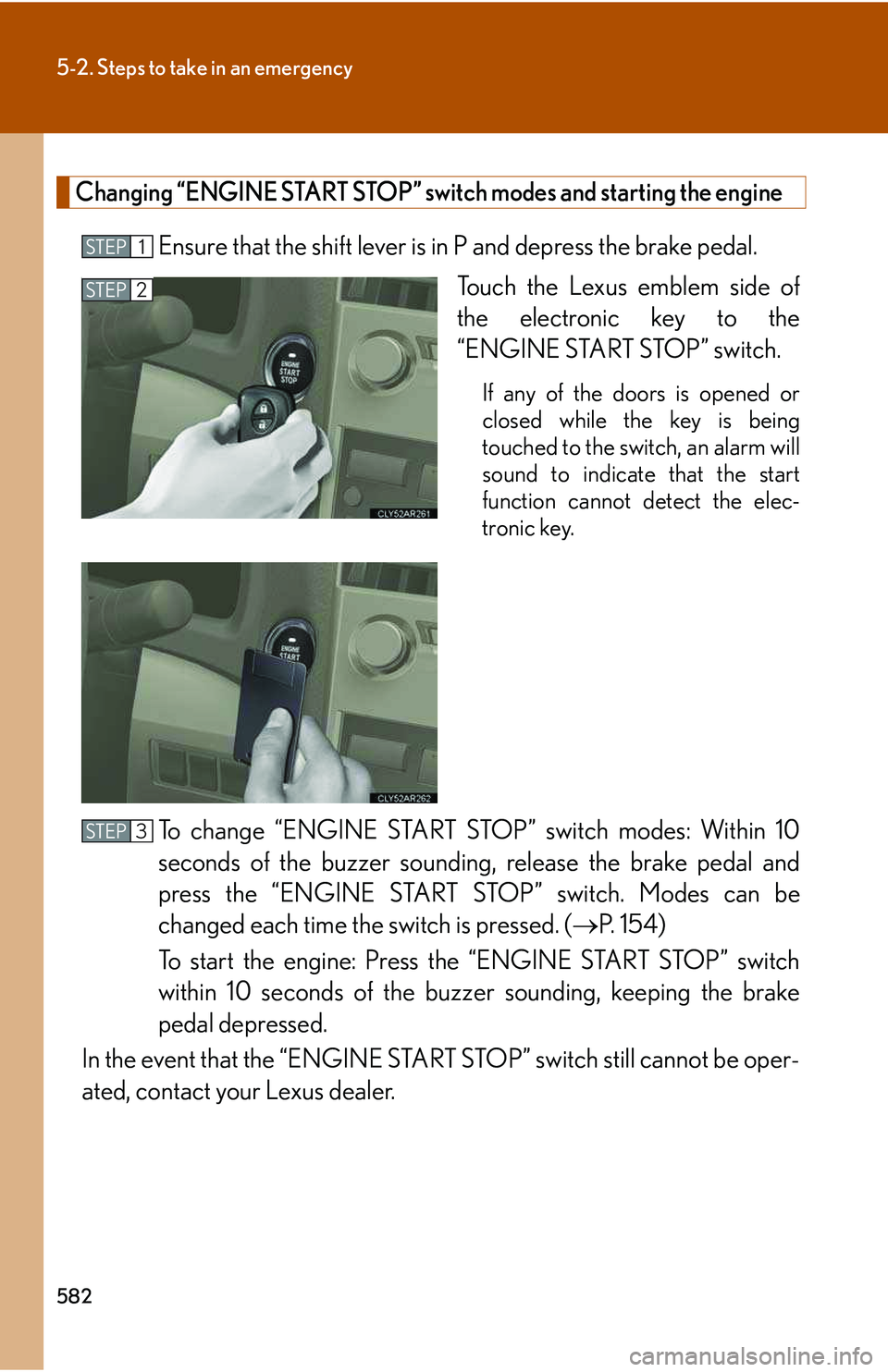
582
5-2. Steps to take in an emergency
Changing “ENGINE START STOP” switch modes and starting the engine
Ensure that the shift lever is in P and depress the brake pedal.
Touch the Lexus emblem side of
the electronic key to the
“ENGINE START STOP” switch.
If any of the doors is opened or
closed while the key is being
touched to the switch, an alarm will
sound to indicate that the start
function cannot detect the elec-
tronic key.
To change “ENGINE START STOP” switch modes: Within 10
seconds of the buzzer sounding, release the brake pedal and
press the “ENGINE START STOP” switch. Modes can be
changed each time the switch is pressed. (�→P. 1 5 4 )
To start the engine: Press the “ENGINE START STOP” switch
within 10 seconds of the buzzer sounding, keeping the brake
pedal depressed.
In the event that the “ENGINE START STOP” switch still cannot be oper-
ated, contact your Lexus dealer.
STEP1
STEP2
STEP3
Page 652 of 821
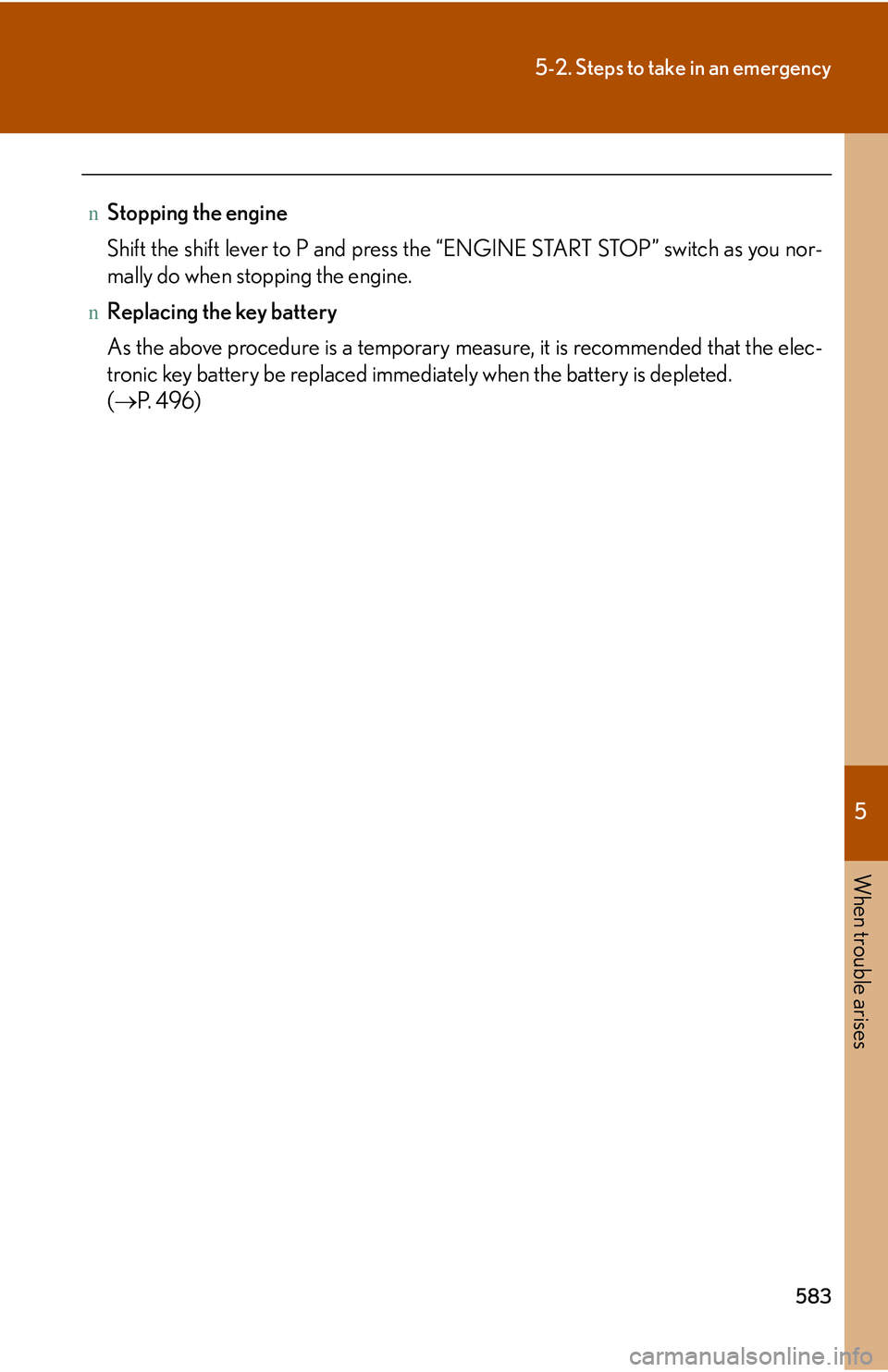
5
When trouble arises
583
5-2. Steps to take in an emergency
nStopping the engine
Shift the shift lever to P and press the “ENGINE START STOP” switch as you nor-
mally do when stopping the engine.
nReplacing the key battery
As the above procedure is a temporary measure, it is recommended that the elec-
tronic key battery be replaced immediately when the battery is depleted.
(�→P. 4 9 6 )
Page 653 of 821
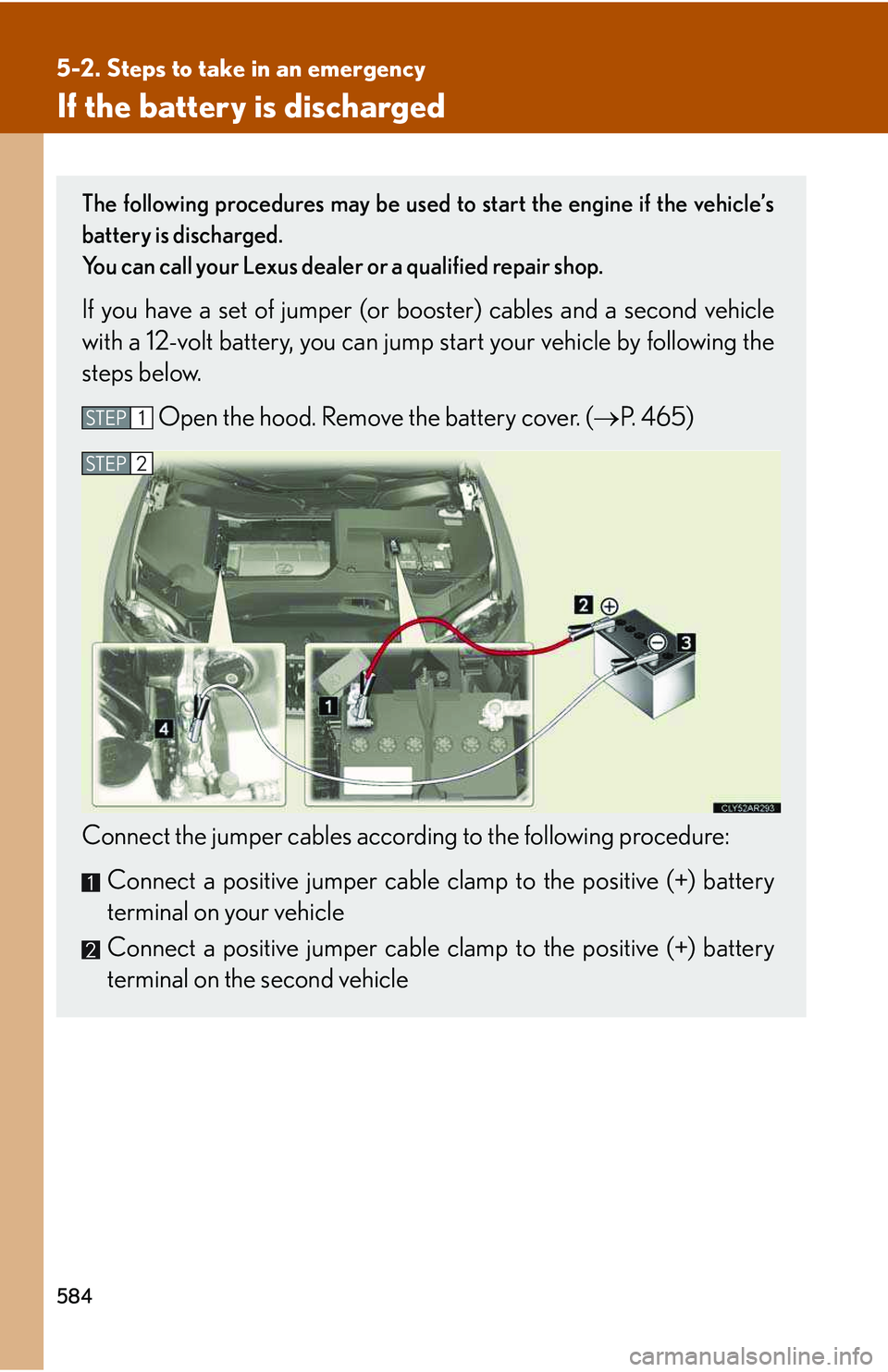
584
5-2. Steps to take in an emergency
If the battery is discharged
The following procedures may be used to start the engine if the vehicle’s
battery is discharged.
You can call your Lexus dealer or a qualified repair shop.
If you have a set of jumper (or booster) cables and a second vehicle
with a 12-volt battery, you can jump start your vehicle by following the
steps below.
Open the hood. Remove the battery cover. (�→P. 465)
Connect the jumper cables according to the following procedure:
Connect a positive jumper cable clamp to the positive (+) battery
terminal on your vehicle
Connect a positive jumper cable clamp to the positive (+) battery
terminal on the second vehicle
STEP1
STEP2
Page 654 of 821
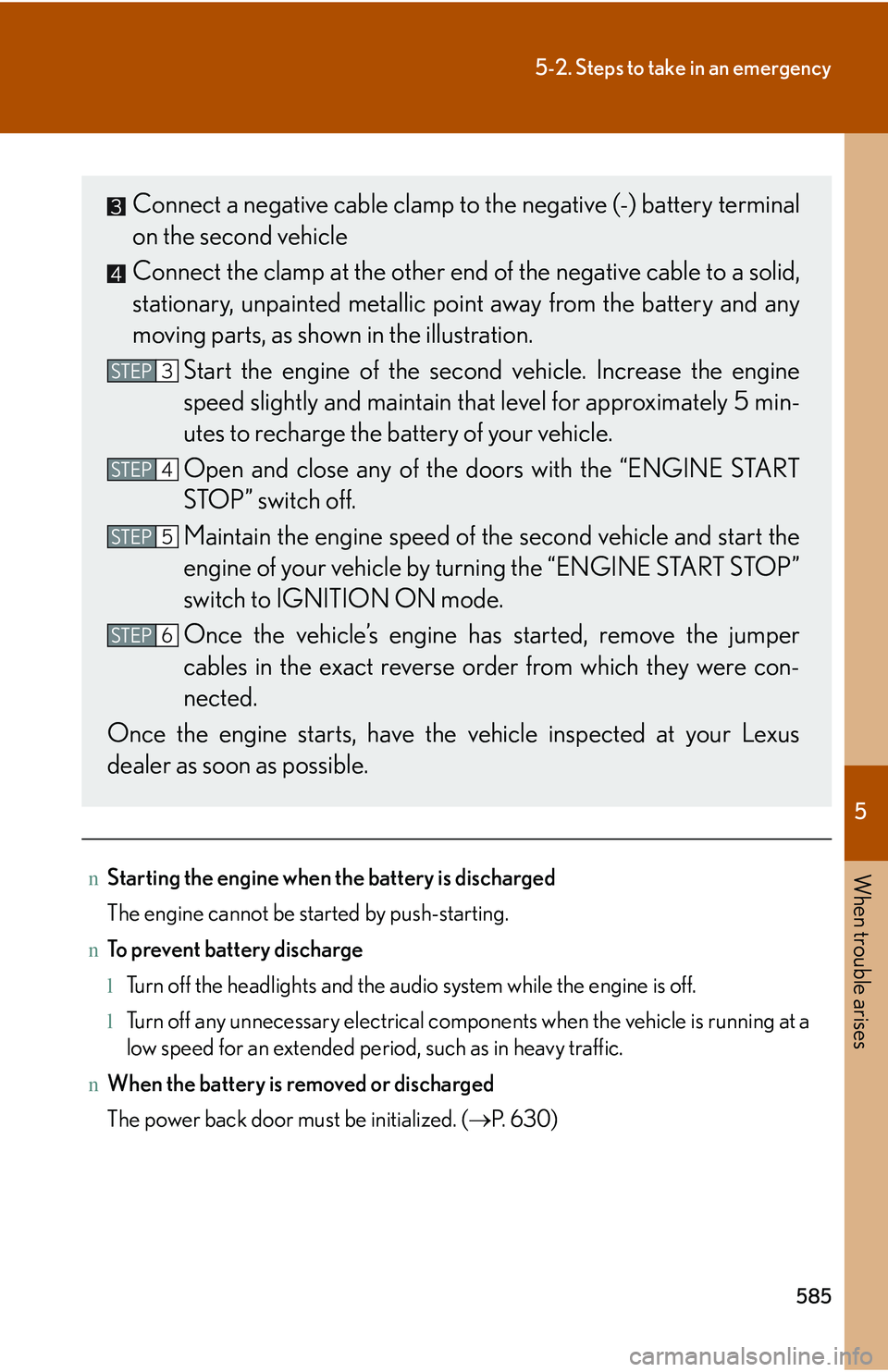
5
When trouble arises
585
5-2. Steps to take in an emergency
nStarting the engine when the battery is discharged
The engine cannot be started by push-starting.
nTo prevent battery discharge
lTurn off the headlights and the audio system while the engine is off.
lTurn off any unnecessary electrical components when the vehicle is running at a
low speed for an extended period, such as in heavy traffic.
nWhen the battery is removed or discharged
The power back door must be initialized. (�→P. 6 3 0 )
Connect a negative cable clamp to the negative (-) battery terminal
on the second vehicle
Connect the clamp at the other end of the negative cable to a solid,
stationary, unpainted metallic point away from the battery and any
moving parts, as shown in the illustration.
Start the engine of the second vehicle. Increase the engine
speed slightly and maintain that level for approximately 5 min-
utes to recharge the battery of your vehicle.
Open and close any of the doors with the “ENGINE START
STOP” switch off.
Maintain the engine speed of the second vehicle and start the
engine of your vehicle by turning the “ENGINE START STOP”
switch to IGNITION ON mode.
Once the vehicle’s engine has started, remove the jumper
cables in the exact reverse order from which they were con-
nected.
Once the engine starts, have the vehicle inspected at your Lexus
dealer as soon as possible.
STEP3
STEP4
STEP5
STEP6
Page 655 of 821
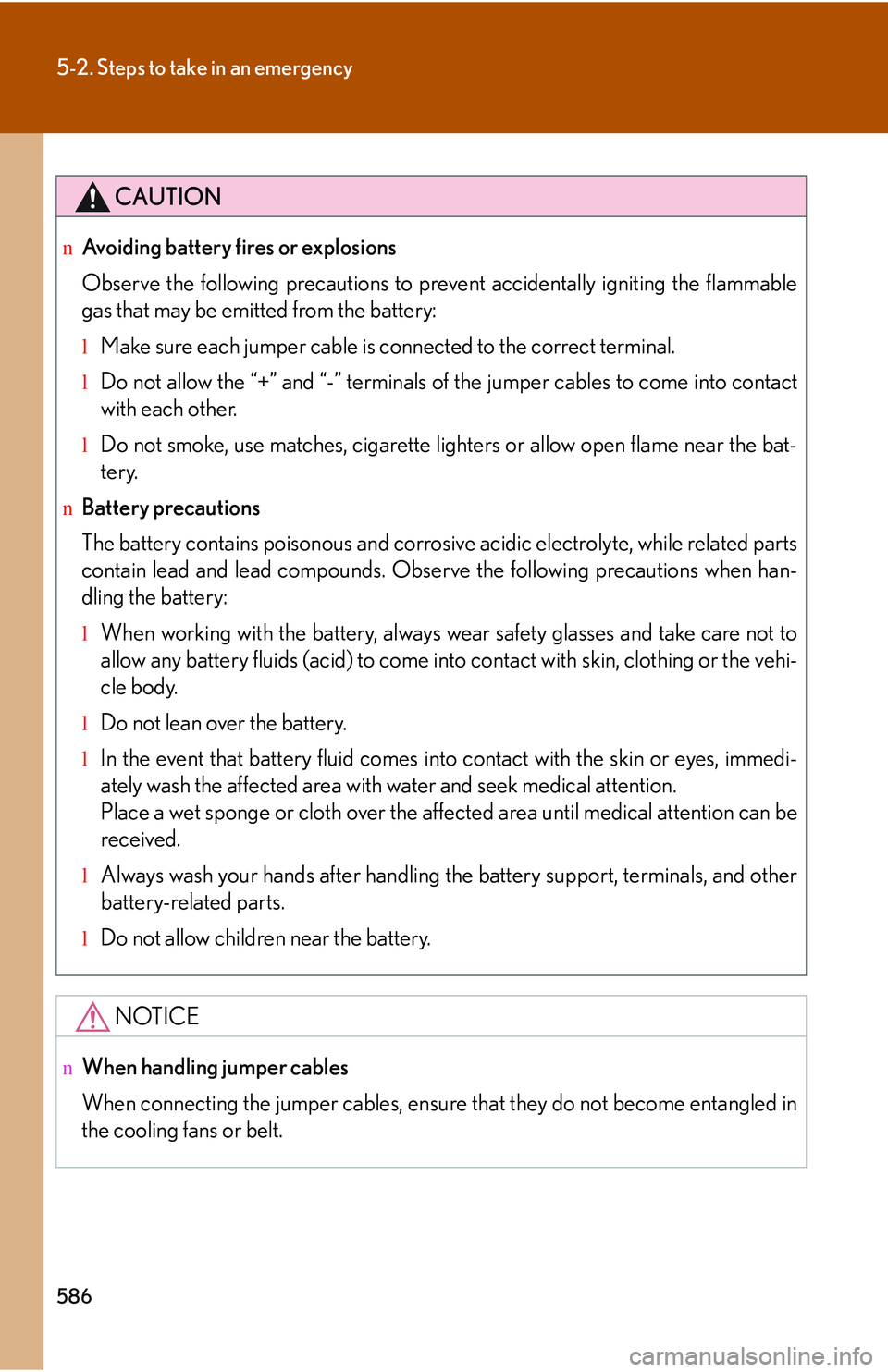
586
5-2. Steps to take in an emergency
CAUTION
nAvoiding battery fires or explosions
Observe the following precautions to prevent accidentally igniting the flammable
gas that may be emitted from the battery:
lMake sure each jumper cable is connected to the correct terminal.
lDo not allow the “+” and “-” terminals of the jumper cables to come into contact
with each other.
lDo not smoke, use matches, cigarette lighters or allow open flame near the bat-
tery.
nBattery precautions
The battery contains poisonous and corrosive acidic electrolyte, while related parts
contain lead and lead compounds. Observe the following precautions when han-
dling the battery:
lWhen working with the battery, always wear safety glasses and take care not to
allow any battery fluids (acid) to come into contact with skin, clothing or the vehi-
cle body.
lDo not lean over the battery.
lIn the event that battery fluid comes into contact with the skin or eyes, immedi-
ately wash the affected area with water and seek medical attention.
Place a wet sponge or cloth over the affected area until medical attention can be
received.
lAlways wash your hands after handling the battery support, terminals, and other
battery-related parts.
lDo not allow children near the battery.
NOTICE
nWhen handling jumper cables
When connecting the jumper cables, ensure that they do not become entangled in
the cooling fans or belt.
Page 656 of 821
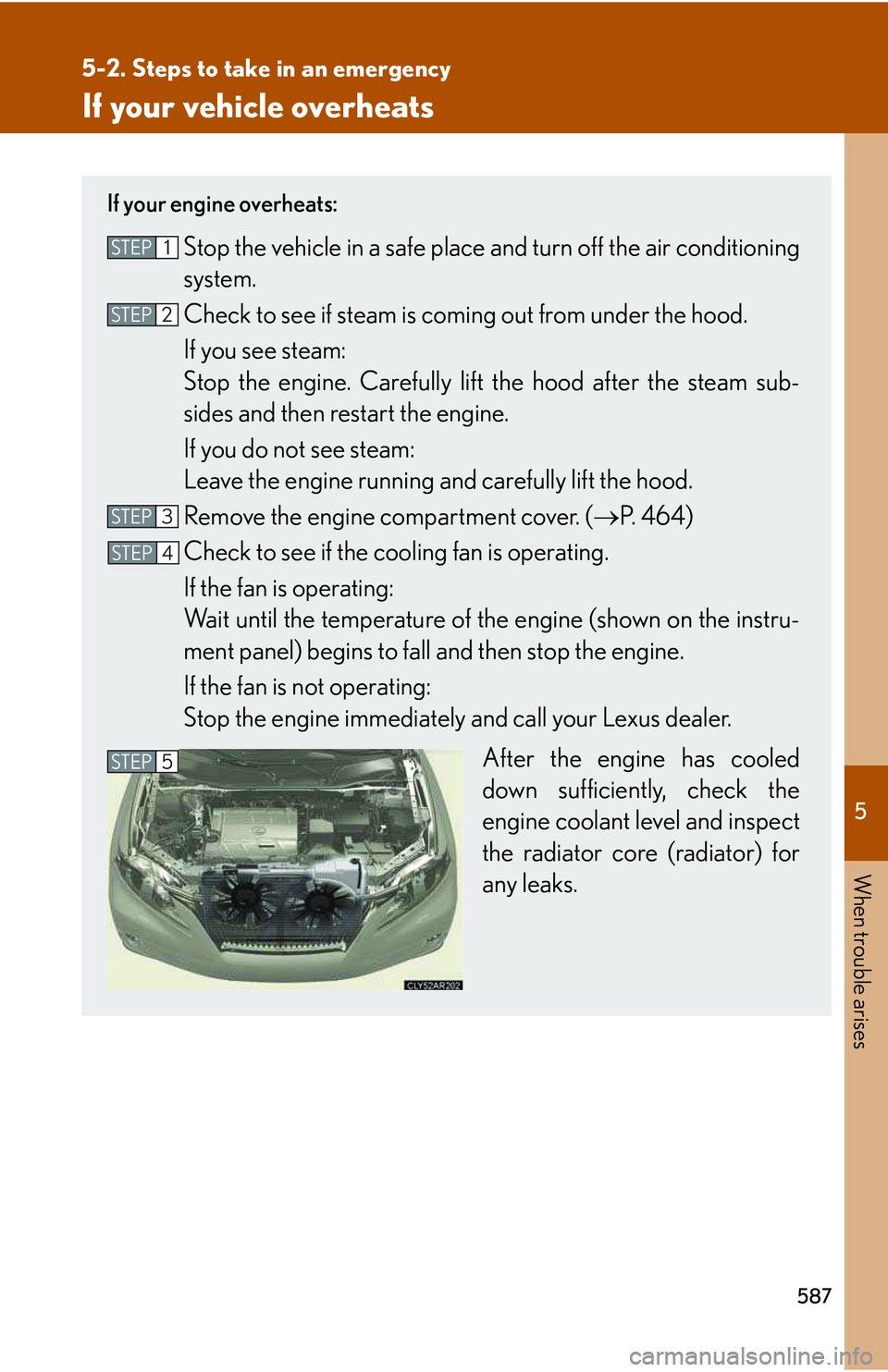
5
When trouble arises
587
5-2. Steps to take in an emergency
If your vehicle overheats
If your engine overheats:
Stop the vehicle in a safe place and turn off the air conditioning
system.
Check to see if steam is coming out from under the hood.
If you see steam:
Stop the engine. Carefully lift the hood after the steam sub-
sides and then restart the engine.
If you do not see steam:
Leave the engine running and carefully lift the hood.
Remove the engine compartment cover. (�→P. 464)
Check to see if the cooling fan is operating.
If the fan is operating:
Wait until the temperature of the engine (shown on the instru-
ment panel) begins to fall and then stop the engine.
If the fan is not operating:
Stop the engine immediately and call your Lexus dealer.
After the engine has cooled
down sufficiently, check the
engine coolant level and inspect
the radiator core (radiator) for
any leaks.
STEP1
STEP2
STEP3
STEP4
STEP5
Page 657 of 821
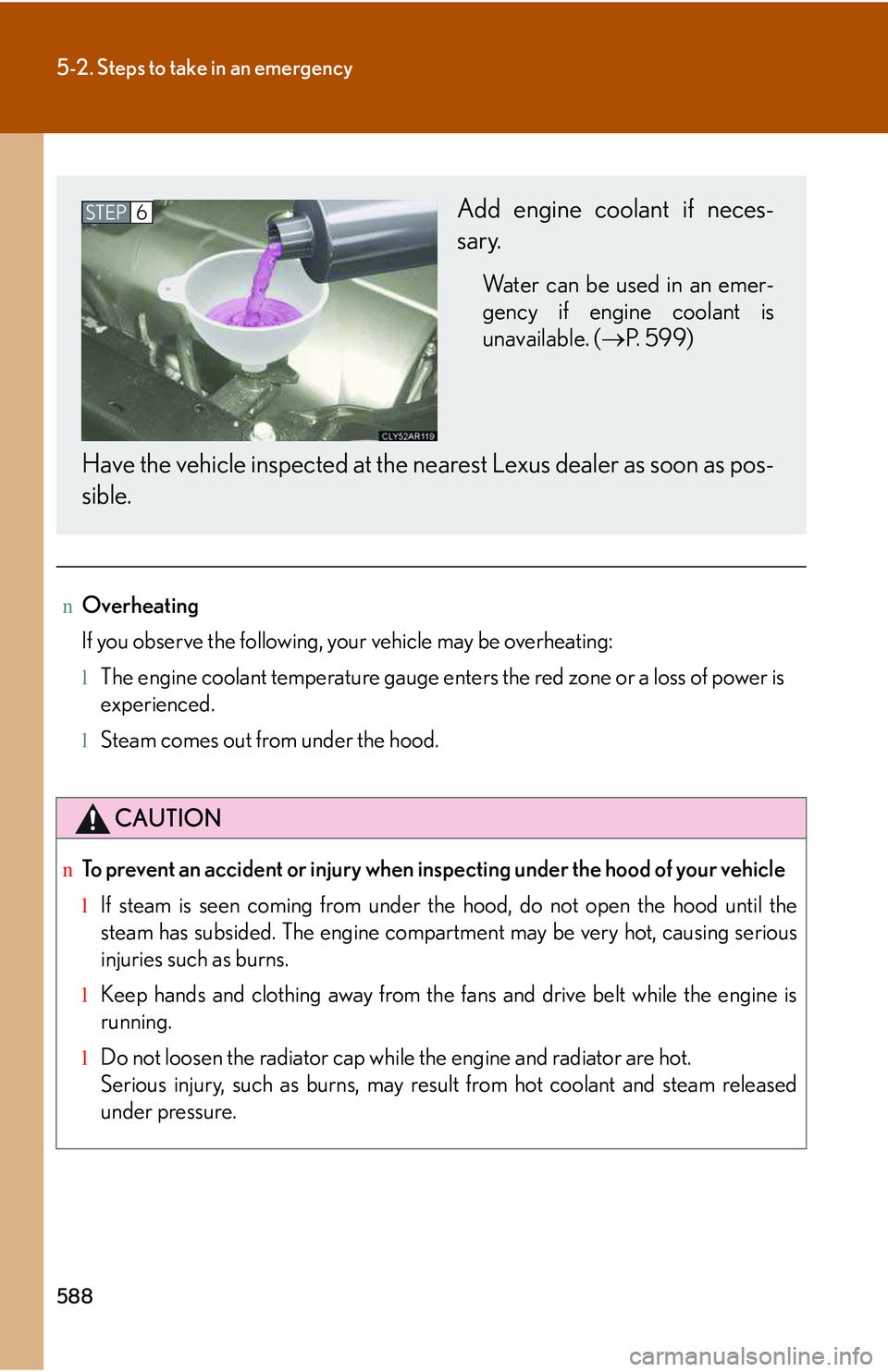
588
5-2. Steps to take in an emergency
nOverheating
If you observe the following, your vehicle may be overheating:
lThe engine coolant temperature gauge enters the red zone or a loss of power is
experienced.
lSteam comes out from under the hood.
CAUTION
nTo prevent an accident or injury when inspecting under the hood of your vehicle
lIf steam is seen coming from under the hood, do not open the hood until the
steam has subsided. The engine compartment may be very hot, causing serious
injuries such as burns.
lKeep hands and clothing away from the fans and drive belt while the engine is
running.
lDo not loosen the radiator cap while the engine and radiator are hot.
Serious injury, such as burns, may result from hot coolant and steam released
under pressure.
Add engine coolant if neces-
sary.
Water can be used in an emer-
gency if engine coolant is
unavailable. (�→P. 599)
Have the vehicle inspected at the nearest Lexus dealer as soon as pos-
sible.
STEP6
Page 658 of 821
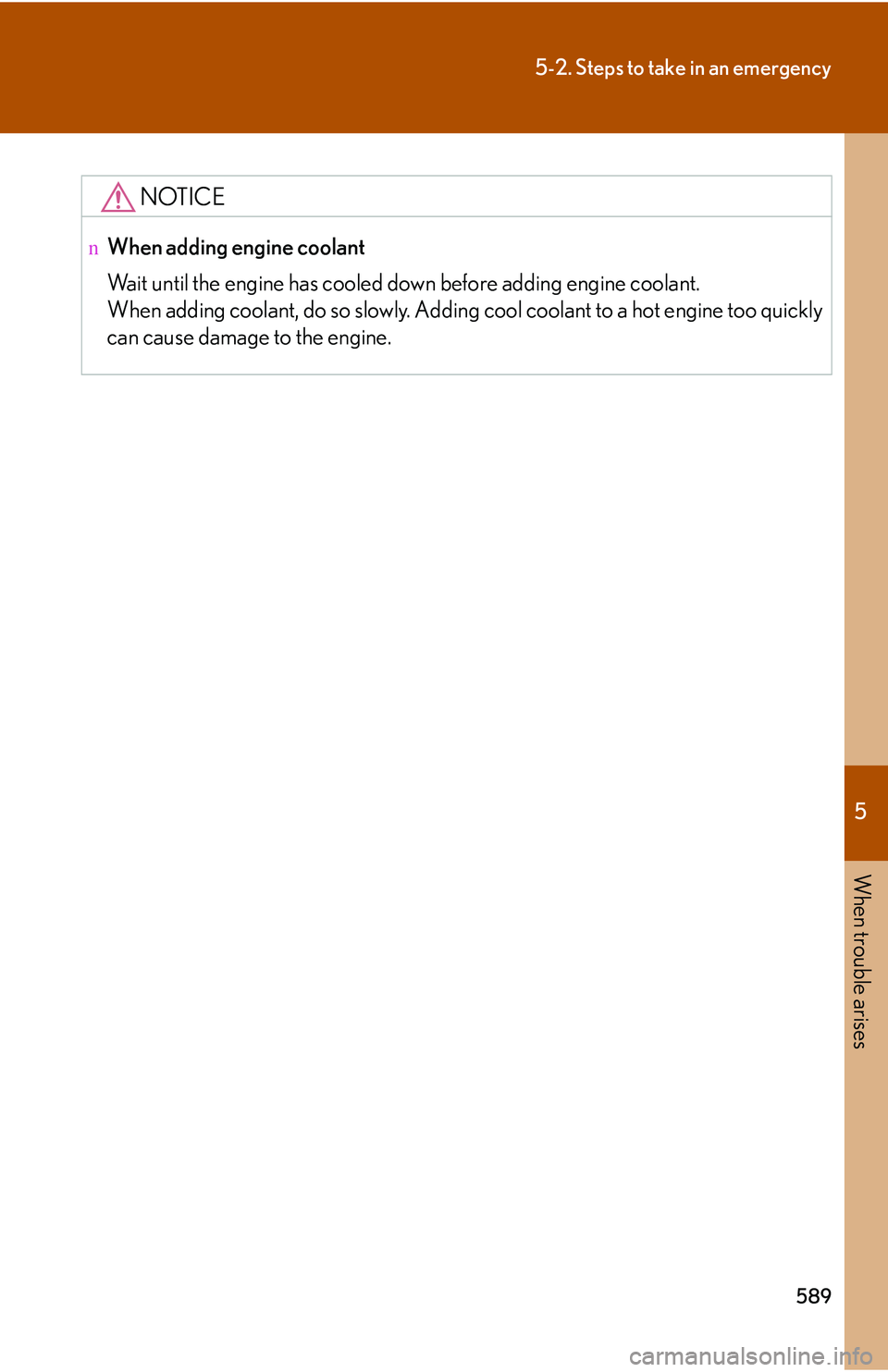
5
When trouble arises
589
5-2. Steps to take in an emergency
NOTICE
nWhen adding engine coolant
Wait until the engine has cooled down before adding engine coolant.
When adding coolant, do so slowly. Adding cool coolant to a hot engine too quickly
can cause damage to the engine.
Page 659 of 821
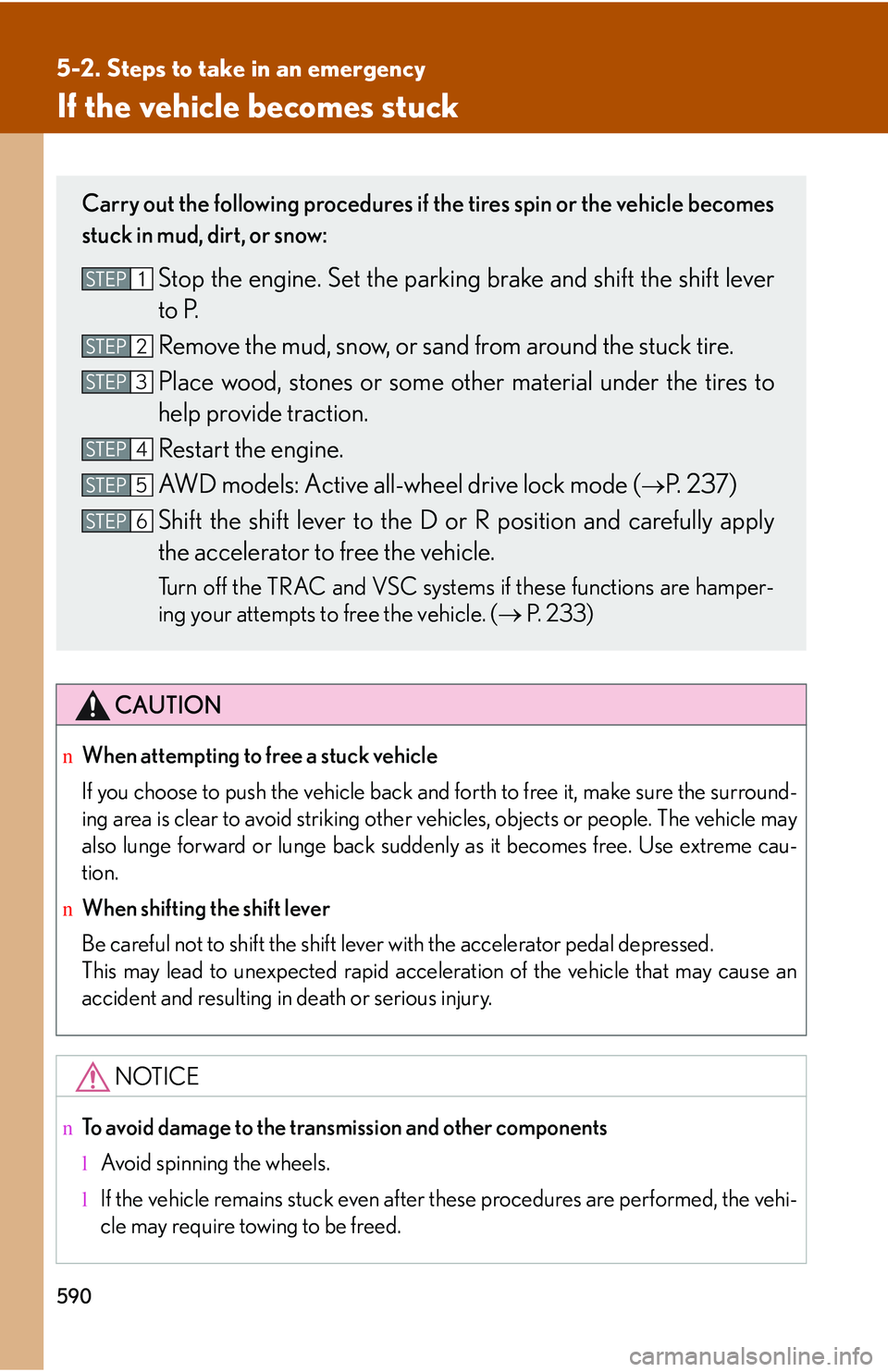
590
5-2. Steps to take in an emergency
If the vehicle becomes stuck
CAUTION
nWhen attempting to free a stuck vehicle
If you choose to push the vehicle back and forth to free it, make sure the surround-
ing area is clear to avoid striking other vehicles, objects or people. The vehicle may
also lunge forward or lunge back suddenly as it becomes free. Use extreme cau-
tion.
nWhen shifting the shift lever
Be careful not to shift the shift lever with the accelerator pedal depressed.
This may lead to unexpected rapid acceleration of the vehicle that may cause an
accident and resulting in death or serious injury.
NOTICE
nTo avoid damage to the transmission and other components
lAvoid spinning the wheels.
lIf the vehicle remains stuck even after these procedures are performed, the vehi-
cle may require towing to be freed.
Carry out the following procedures if the tires spin or the vehicle becomes
stuck in mud, dirt, or snow:
Stop the engine. Set the parking brake and shift the shift lever
to P.
Remove the mud, snow, or sand from around the stuck tire.
Place wood, stones or some other material under the tires to
help provide traction.
Restart the engine.
AWD models: Active all-wheel drive lock mode (�→P. 237)
Shift the shift lever to the D or R position and carefully apply
the accelerator to free the vehicle.
Turn off the TRAC and VSC systems if these functions are hamper-
ing your attempts to free the vehicle. (�→ P. 2 3 3 )
STEP1
STEP2
STEP3
STEP4
STEP5
STEP6
Page 660 of 821
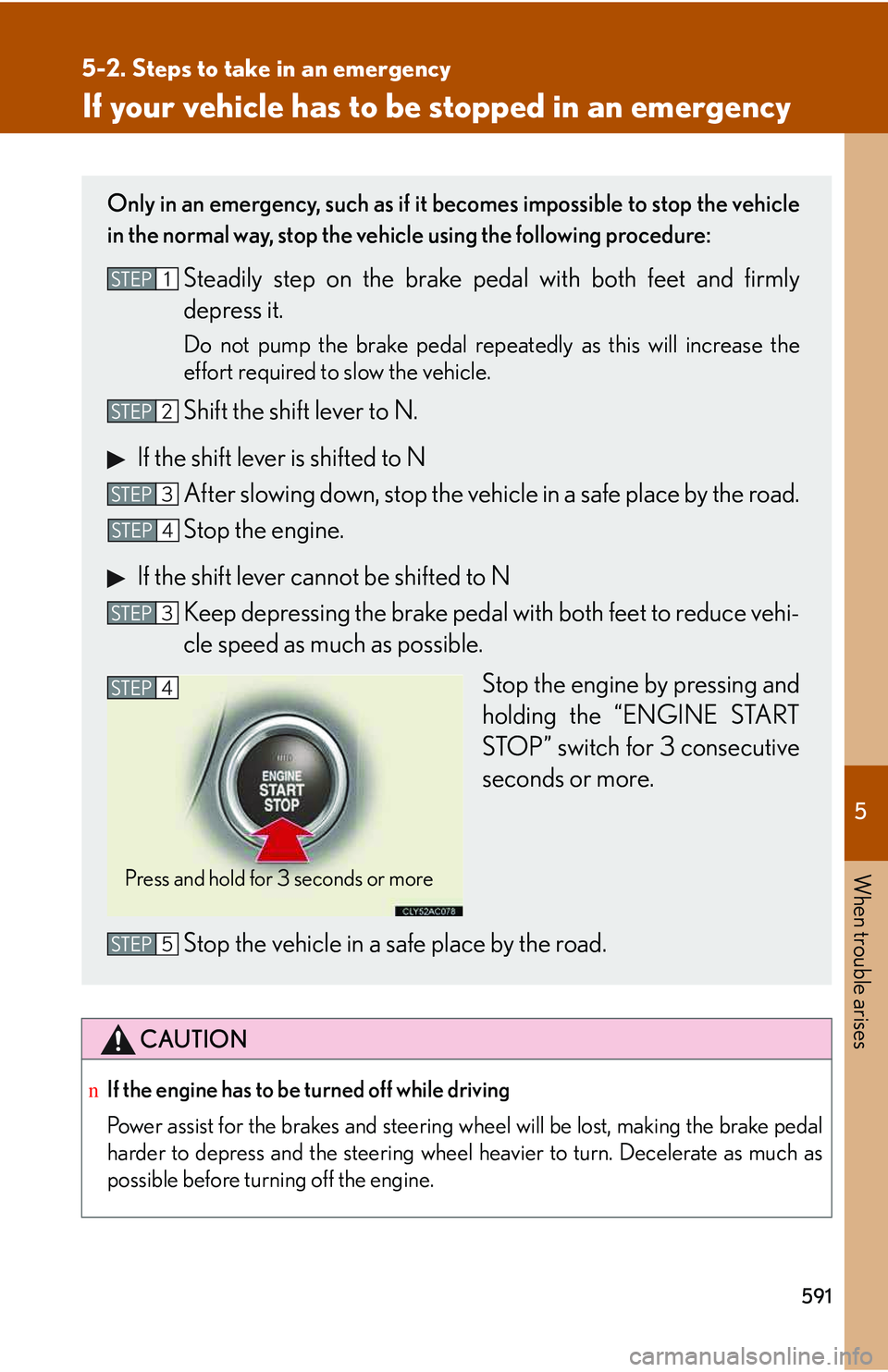
5
When trouble arises
591
5-2. Steps to take in an emergency
If your vehicle has to be stopped in an emergency
CAUTION
nIf the engine has to be turned off while driving
Power assist for the brakes and steering wheel will be lost, making the brake pedal
harder to depress and the steering wheel heavier to turn. Decelerate as much as
possible before turning off the engine.
Only in an emergency, such as if it becomes impossible to stop the vehicle
in the normal way, stop the vehicle using the following procedure:
Steadily step on the brake pedal with both feet and firmly
depress it.
Do not pump the brake pedal repeatedly as this will increase the
effort required to slow the vehicle.
Shift the shift lever to N.
If the shift lever is shifted to N
After slowing down, stop the vehicle in a safe place by the road.
Stop the engine.
If the shift lever cannot be shifted to N
Keep depressing the brake pedal with both feet to reduce vehi-
cle speed as much as possible.
Stop the engine by pressing and
holding the “ENGINE START
STOP” switch for 3 consecutive
seconds or more.
Stop the vehicle in a safe place by the road.
STEP1
STEP2
STEP3
STEP4
STEP3
Press and hold for 3 seconds or more
STEP4
STEP5